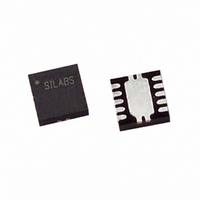C8051F305-GMR Silicon Laboratories Inc, C8051F305-GMR Datasheet - Page 101

C8051F305-GMR
Manufacturer Part Number
C8051F305-GMR
Description
IC 8051 MCU 2K FLASH 11QFN
Manufacturer
Silicon Laboratories Inc
Series
C8051F30xr
Specifications of C8051F305-GMR
Core Processor
8051
Core Size
8-Bit
Speed
25MHz
Connectivity
SMBus (2-Wire/I²C), UART/USART
Peripherals
POR, PWM, WDT
Number Of I /o
8
Program Memory Size
2KB (2K x 8)
Program Memory Type
FLASH
Ram Size
256 x 8
Voltage - Supply (vcc/vdd)
2.7 V ~ 3.6 V
Oscillator Type
External
Operating Temperature
-40°C ~ 85°C
Package / Case
11-VQFN
For Use With
336-1444 - ADAPTER PROGRAM TOOLSTICK F300
Lead Free Status / RoHS Status
Lead free / RoHS Compliant
Eeprom Size
-
Data Converters
-
Available stocks
Company
Part Number
Manufacturer
Quantity
Price
Part Number:
C8051F305-GMR
Manufacturer:
SILICONLABS/芯科
Quantity:
20 000
11.4. External Crystal Example
If a crystal or ceramic resonator is used as an external oscillator source for the MCU, the circuit should be
configured as shown in Figure 11.1, Option 1. The External Oscillator Frequency Control value (XFCN)
should be chosen from the Crystal column of the table in SFR Definition 11.3 (OSCXCN register). For
example, an 11.0592 MHz crystal requires an XFCN setting of 111b.
When the crystal oscillator is first enabled, the oscillator amplitude detection circuit requires a settling time
to achieve proper bias. Introducing a delay of 1 ms between enabling the oscillator and checking the
XTLVLD bit will prevent a premature switch to the external oscillator as the system clock. Switching to the
external oscillator before the crystal oscillator has stabilized can result in unpredictable behavior. The rec-
ommended procedure is:
Note: Tuning-fork crystals may require additional settling time before XTLVLD returns a valid
result.
The capacitors shown in the external crystal configuration provide the load capacitance required by the
crystal for correct oscillation. These capacitors are “in series” as seen by the crystal and “in parallel” with
the stray capacitance of the XTAL1 and XTAL2 pins.
Note: The load capacitance depends upon the crystal and the manufacturer. Please refer to the
crystal data sheet when completing these calculations.
For example, a tuning-fork crystal of 32.768 kHz with a recommended load capacitance of 12.5 pF should
use the configuration shown in Figure 12.1, Option 1. The total value of the capacitors and the stray capac-
itance of the XTAL pins should equal 25 pF. With a stray capacitance of 3 pF per pin, the 22 pF capacitors
yield an equivalent capacitance of 12.5 pF across the crystal, as shown in Figure 11.2.
Step 1. Force the XTAL1 and XTAL2 pins low by writing 0’s to the port latch.
Step 2. Configure XTAL1 and XTAL2 as analog inputs.
Step 3. Enable the external oscillator.
Step 4. Wait at least 1 ms.
Step 5. Poll for XTLVLD => ‘1’.
Step 6. Switch the system clock to the external oscillator.
Figure 11.2. 32.768 kHz External Crystal Example
32.768 kHz
22 pF
22 pF
Rev. 2.9
10 M
C8051F300/1/2/3/4/5
XTAL1
XTAL2
101











